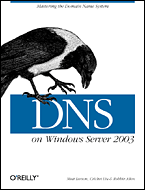| [ Team LiB ] |
|
 | |
| • | Table of Contents |
| • | Index |
| • | Reviews |
| • | Reader Reviews |
| • | Errata |
| • | Academic |
| DNS on Windows Server 2003 | ||
| By Robbie Allen, Matt Larson, Cricket Liu | ||
| Publisher | : O'Reilly | |
| Pub Date | : December 2003 | |
| ISBN | : 0-596-00562-8 | |
| Pages | : 416 | |
| [ Team LiB ] |
|